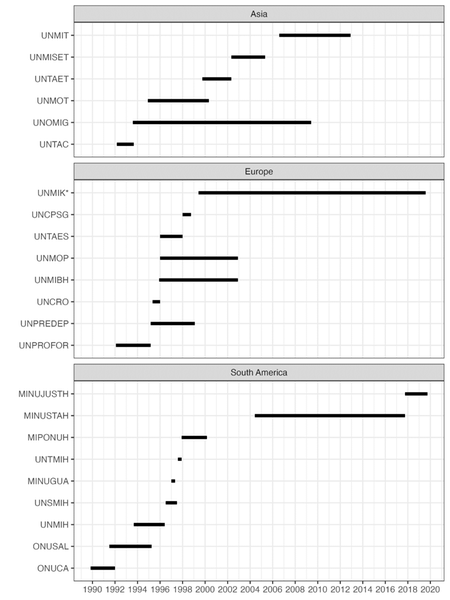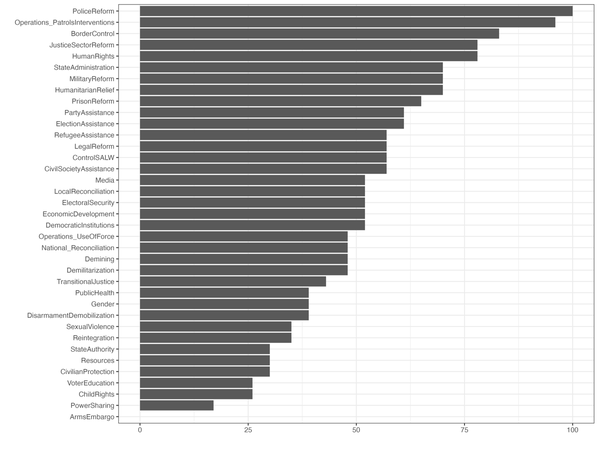The Peacekeeping Activity (PACT) Dataset 2.0
PACT 2.0 provides detailed information on the activities of peacekeepers during United Nations Peacekeeping Operations (UNPKOs), recording 37 distinct activities. Additionally, it categorizes peacekeepers' involvement into 8 different engagement levels. Lastly, it indicates whether each activity was conducted in collaboration with an international actor.
Explore PACT 2.0
Use the dashboard for Interactive Visualization.
UN peacekeeping activities in Europe, Asia, and the Americas, 1989 – 2019
The dataset covers 23 UNPKOs in Europe, Asia, and the Americas, based on data derived from 389 UN Secretary-General (UNSG) progress reports.

UNPKOs in the PACT 2.0 dataset, 1989-2019. *Still ongoing in 2019.
Activities in the dataset
PACT 2.0 covers 37 different activities. The y-axis in the plot lists all activities coded by PACT 2.0. The x-axis shows the share of UNPKOs (in %) that implemented the activities at least once during their lifetime. While Police Reform was implemented by all UNPKOs covered by PACT 2.0, Arms Embargo was implemented by no UNPKO.

Share of UNPKOs (in %) that implemented the respective activities at least once.
Engagement Categories in the dataset
PACT 2.0 codes 8 different engagement categories that provide information on how peacekeepers implement activities. The plot shows the yearly implementation frequency for each engagement category. While 'Assist' is the most frequent mode of engagement for implementing activities, 'Provide Security' is the least frequent.

Number of implemented engagement categories per year.
Why study UN peacekeeping activities in Europe, Asia, and the Americas?
UNPKOs have been deployed in conflict-affected countries for decades. However, there is little research on the specific activities that peacekeepers undertake upon deployment. PACT 2.0 provides detailed information on peacekeepers' activities and their level of engagement. Existing quantitative research has predominantly focused on Africa, arguing that most current missions are there. PACT 2.0 also enables the study of peacekeeping activities beyond Africa. It extends previous data collections by Hannah Smidt and Rob Blair (PACT 1.0), filling in the gaps to achieve global coverage of peacekeeping activities. UNPKOs in Europe, Asia, and the Americas differ from those in Africa as they primarily occur in post-conflict settings or areas of gang violence, rarely involve robust mandates, and sometimes function as transitional authorities. Examining these "forgotten" UNPKOs enhances our understanding of peacekeeping. Additionally, it contributes to the discussion on the future of 'stabilization missions' by exploring the conditions most suitable for peacekeeping, incorporating data from all UNPKOs.
Studies using PACT 2.0
- Otto, S., Kube, F., & Smidt, H. (2024). UN peacekeeping upon deployment: Peacekeeping activities in theory and practice. Cooperation and Conflict, 0(0). https://doi.org/10.1177/00108367241235888
- Replication data: https://doi.org/10.7910/DVN/W2NKY2
Contributors to PACT 2.0
Masumi Honda, Sofia Kahma, Joanna Grace Nakabiito, and Felix Kube. Special thanks go to Hannah Smidt (https://hannahsmidt.com/), who introduced us to the coding procedure.
